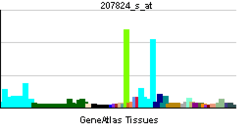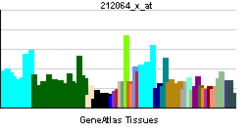MAZ (gene)
Myc-associated zinc finger protein is a protein that in humans is encoded by the MAZ gene.[1][2][3]
Interactions
MAZ (gene) has been shown to interact with BPTF[4] and Deleted in Colorectal Cancer.[5]
References
- ↑ Pyrc JJ, Moberg KH, Hall DJ (May 1992). "Isolation of a novel cDNA encoding a zinc-finger protein that binds to two sites within the c-myc promoter". Biochemistry 31 (16): 4102–10. doi:10.1021/bi00131a029. PMID 1567856.
- ↑ Bossone SA, Asselin C, Patel AJ, Marcu KB (September 1992). "MAZ, a zinc finger protein, binds to c-MYC and C2 gene sequences regulating transcriptional initiation and termination". Proc Natl Acad Sci U S A 89 (16): 7452–6. doi:10.1073/pnas.89.16.7452. PMC 49728. PMID 1502157.
- ↑ "Entrez Gene: MAZ MYC-associated zinc finger protein (purine-binding transcription factor)".
- ↑ Jordan-Sciutto KL, Dragich JM, Caltagarone J, Hall DJ, Bowser R (March 2000). "Fetal Alz-50 clone 1 (FAC1) protein interacts with the Myc-associated zinc finger protein (ZF87/MAZ) and alters its transcriptional activity". Biochemistry 39 (12): 3206–15. doi:10.1021/bi992211q. PMID 10727212.
- ↑ Ugai H, Li HO, Komatsu M, Tsutsui H, Song J, Shiga T et al. (September 2001). "Interaction of Myc-associated zinc finger protein with DCC, the product of a tumor-suppressor gene, during the neural differentiation of P19 EC cells". Biochem. Biophys. Res. Commun. 286 (5): 1087–97. doi:10.1006/bbrc.2001.5469. PMID 11527412.
Further reading
- Parks CL, Shenk T (1996). "The serotonin 1a receptor gene contains a TATA-less promoter that responds to MAZ and Sp1.". J. Biol. Chem. 271 (8): 4417–30. doi:10.1074/jbc.271.8.4417. PMID 8626793.
- Tsutsui H, Sakatsume O, Itakura K, Yokoyama KK (1996). "Members of the MAZ family: a novel cDNA clone for MAZ from human pancreatic islet cells.". Biochem. Biophys. Res. Commun. 226 (3): 801–9. doi:10.1006/bbrc.1996.1432. PMID 8831693.
- Bonaldo MF, Lennon G, Soares MB (1997). "Normalization and subtraction: two approaches to facilitate gene discovery.". Genome Res. 6 (9): 791–806. doi:10.1101/gr.6.9.791. PMID 8889548.
- Song J, Murakami H, Tsutsui H, Tang X, Matsumura M, Itakura K et al. (1998). "Genomic organization and expression of a human gene for Myc-associated zinc finger protein (MAZ).". J. Biol. Chem. 273 (32): 20603–14. doi:10.1074/jbc.273.32.20603. PMID 9685418.
- Song J, Murakami H, Yang ZQ, Koga C, Adati N, Murata T et al. (1998). "Human genes for KNSL4 and MAZ are located close to one another on chromosome 16p11.2.". Genomics 52 (3): 374–7. doi:10.1006/geno.1998.5452. PMID 9790757.
- Tsutsui H, Geltinger C, Murata T, Itakura K, Wada T, Handa H et al. (1999). "The DNA-binding and transcriptional activities of MAZ, a myc-associated zinc finger protein, are regulated by casein kinase II.". Biochem. Biophys. Res. Commun. 262 (1): 198–205. doi:10.1006/bbrc.1999.1130. PMID 10448092.
- Loftus BJ, Kim UJ, Sneddon VP, Kalush F, Brandon R, Fuhrmann J et al. (1999). "Genome duplications and other features in 12 Mb of DNA sequence from human chromosome 16p and 16q.". Genomics 60 (3): 295–308. doi:10.1006/geno.1999.5927. PMID 10493829.
- Jordan-Sciutto KL, Dragich JM, Caltagarone J, Hall DJ, Bowser R (2000). "Fetal Alz-50 clone 1 (FAC1) protein interacts with the Myc-associated zinc finger protein (ZF87/MAZ) and alters its transcriptional activity.". Biochemistry 39 (12): 3206–15. doi:10.1021/bi992211q. PMID 10727212.
- Ugai H, Li HO, Komatsu M, Tsutsui H, Song J, Shiga T et al. (2001). "Interaction of Myc-associated zinc finger protein with DCC, the product of a tumor-suppressor gene, during the neural differentiation of P19 EC cells.". Biochem. Biophys. Res. Commun. 286 (5): 1087–97. doi:10.1006/bbrc.2001.5469. PMID 11527412.
- Ray BK, Murphy R, Ray P, Ray A (2003). "SAF-2, a splice variant of SAF-1, acts as a negative regulator of transcription.". J. Biol. Chem. 277 (48): 46822–30. doi:10.1074/jbc.M206299200. PMID 12270922.
- Bataller L, Wade DF, Graus F, Rosenfeld MR, Dalmau J (2004). "The MAZ protein is an autoantigen of Hodgkin's disease and paraneoplastic cerebellar dysfunction.". Ann. Neurol. 53 (1): 123–7. doi:10.1002/ana.10434. PMID 12509857.
- Ray A, Kuroki K, Cook JL, Bal BS, Kenter K, Aust G et al. (2003). "Induction of matrix metalloproteinase 1 gene expression is regulated by inflammation-responsive transcription factor SAF-1 in osteoarthritis.". Arthritis Rheum. 48 (1): 134–45. doi:10.1002/art.10706. PMID 12528113.
- Leroy C, Manen D, Rizzoli R, Lombès M, Silve C (2005). "Functional importance of Myc-associated zinc finger protein for the human parathyroid hormone (PTH)/PTH-related peptide receptor-1 P2 promoter constitutive activity.". J. Mol. Endocrinol. 32 (1): 99–113. doi:10.1677/jme.0.0320099. PMID 14765995. Vancouver style error (help)
- Ray A, Shakya A, Kumar D, Ray BK (2004). "Overexpression of serum amyloid A-activating factor 1 inhibits cell proliferation by the induction of cyclin-dependent protein kinase inhibitor p21WAF-1/Cip-1/Sdi-1 expression.". J. Immunol. 172 (8): 5006–15. doi:10.4049/jimmunol.172.8.5006. PMID 15067082.
- Ray BK, Shakya A, Turk JR, Apte SS, Ray A (2005). "Induction of the MMP-14 gene in macrophages of the atherosclerotic plaque: role of SAF-1 in the induction process.". Circ. Res. 95 (11): 1082–90. doi:10.1161/01.RES.0000150046.48115.80. PMID 15528467.
- Gromak N, West S, Proudfoot NJ (2006). "Pause sites promote transcriptional termination of mammalian RNA polymerase II.". Mol. Cell. Biol. 26 (10): 3986–96. doi:10.1128/MCB.26.10.3986-3996.2006. PMC 1488997. PMID 16648491.
- Ray A, Shakya A, Kumar D, Benson MD, Ray BK (2006). "Inflammation-responsive transcription factor SAF-1 activity is linked to the development of amyloid A amyloidosis.". J. Immunol. 177 (4): 2601–9. doi:10.4049/jimmunol.177.4.2601. PMID 16888022.

